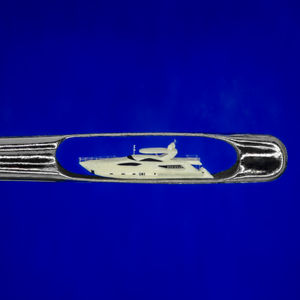It's a small world for superstar sculptor of microscopic artwork
Willard Wigan plucks a hair from his eyelash to make a paintbrush. The ones in the shops just lack precision, he says.

And when you are painting a sculpture of Tyson Fury that fits on the head of a nail, precision is pretty important.
“This is larger than I normally do,” says Willard. This remarkable piece of art, entitled Hard as Nails, is about double the height of the head of a match, and slightly slimmer. It captures the world boxing champion right down to the words ‘Gipsy King’ on his tiny shorts, in letters so small that one needs a microscope to read it. Or at least a specialist smartphone.
Willard is a man in demand at the moment. His tiny sculptures are the must-have gift for the rich and famous. Simon Cowell has one of Frank Sinatra. Controversial tycoon Sir Philip Green reputedly paid £60,000 for one of himself with Kate Moss. In 2007, health club magnate David Lloyd reportedly paid £11.2 million for 70 of his sculptures.
He is about to take a leading role in an eight-part television series for Channel Four, and an exhibition if his work at Birmingham Contemporary Art Gallery runs until Friday. If that is not enough exposure, his rags-to-riches life story is also being made into a new drama which will be serialised on Netflix.
Not bad for a boy whose teacher told him he “had a brain the size of a pea”, and would never amount to anything.
“I’m the Muhammad Ali of microscopic art,” says Willard, who grew up on the Ashmore Park estate in Wolverhampton.
“Microsurgeons have seen my work, they have said ‘we cannot do that, our machines can’t do that’,” he says.
Willard is secretive about what he is working on at the moment, but promises it is going to be something special.
“I’ve got something coming up that’s going to be quite surprising to a lot of people,” he says. And when Willard says it is going to be a surprise, you can prepare to be amazed.
Now 64, Willard is a millionaire several times over, with a lifestyle that his former teachers can only dream of.
He was appointed an MBE in 2007 after the Queen commissioned him to make a tiny sculpture of the crown she wore for her coronation.
And he will also be one of two resident experts on the forthcoming Channel 4 series The Great Big Tiny Design Challenge, which will see design experts invited to carry out a Grand Designs style renovation – of a doll’s house.
But despite being able to enjoy all the trappings of success, the cruel humiliation he suffered as a child still rankles.
“One of the teachers used to drag me around the school, bringing me in front of all the different classes and telling them ‘this is what a failure looks like',” he bristles.
“They told me I would never amount to anything, but I have achieved far more than anyone else who went to that school ever did.”
For Willard, his school days were a tough and lonely time. In later life he was diagnosed with autism and dyslexia. But back in the 1960s autism was barely understood by the country’s leading educational psychologists, let alone primary-school teachers in suburban Wolverhampton. Instead of seeing Willard as flawed-but-gifted genius, he was viewed as a problem, a lost cause, an example to others of what happens if you don’t conform.
But in this isolation, Willard’s creative side flourished. As he sat alone, ridiculed by both classmates and teachers, his imagination started to work overtime.
“I began to notice things that everybody else ignored, like particles of dust and red mites crawling on the pavement,” he says.
“At home, when the heating pipes made noises, I imagined a tiny person was in there skipping with a rope. The fantasy world of tiny things became my escape.”
Willard’s father was a foundry worker, and there wasn’t much money in the family home.
“We didn’t have money for toys, so I made my own,” he says.
“My first creation was a house for ants, when I was five. I took wood splinters and shaped a crude bungalow and some tiny furniture. Then I invited the ant in with honey and soon I was a landlord of a colony.”
Willard left school at 15, and followed his father into the foundry, but after buying a second-hand microscope for £4, he started making tiny wood sculptures.
His mother, who he says was a huge influence on his life, quickly spotted the potential of his work, and encouraged him to make his work smaller and smaller.
“’The smaller your work, the bigger your name’, she used to say,” he recalls fondly. “She made me believe in myself and I set off on a quest to do smaller and smaller pieces.”
He would set his tiny carvings on the end of cocktail sticks which he displayed in a window, and people began to take an interest. “People saw my work and interest grew and I was invited to exhibit at a gallery in Bath.”







At present Willard is working on a sculpture to commemorate the Commonwealth Games – he can’t reveal much at his stage – and some of his recent works make his Tyson Fury look like a giant. With sculptures measuring 0.0002in or 0.005 mm, the metric v imperial debate seems somewhat redundant - it is just impossible to imagine the scale whatever system you prefer.
He was recently commissioned to make a house that sits inside the eye of a needle, and the detail extends right down to the letterbox and conservatory to the side. He has produced the world’s smallest super yacht – a Sunseeker to be precise – which fits inside a the eye of a needle.
Another captures the musician Johanna Martzy playing the violin.
The Mount Rushmore National Memorial in South Dakota is famed for its vast sculpture, depicting US presidents George Washington, Thomas Jefferson, Theodore Roosevelt and Abraham Lincoln, but Willard’s version is barely larger than a speck of dust.
The Biblical metaphor of a camel going through the eye of a needle is represented in another sculpture, which actually features nine of the beasts in microscopic form.
“I did one to represent the NHS, a nurse having a fight with Covid on the end of a hypodermic, I did that as a symbol of strength,” he says.
Working on such a tiny scale does not make for an easy life. Willard says each piece takes five to eight weeks, working up to 18 hours a day.
He says: "I lock myself away and go into a trance-like meditative state in which I slow my nervous system and work between heartbeats because the slightest tremor can destroy a piece. It drives me insane.
"Sometimes I motivate myself by entering into a fantasy world in which I imagine I'm operating on a tiny person to save their life."
But the biggest bugbear is the risk of destroying something so tiny and fragile after he has completed it.
But the worst part is when something goes wrong after the piece is finished. There has been more than one occasion when he has got too close and actually inhaled his own sculptures.
"Eight weeks' work up my nostril!"
Such accidents can also prove very expensive, as his work does not come cheap. His Mount Rushmore is for sale at £107,000. His recreation of Johannes Vermeer’s famous painting Girl With A Pearl Earring, slightly smaller than the head of a match, is £147,000. While the World’s Smallest Super Yacht is actually cheaper than the real thing at £160,000, it is still a lot of money for something the naked eye cannot even see.
But his piece de resistance is a golden dragon, which has been created in such tiny detail it is hard to comprehend.
“It is one of the hardest things I have ever done, I almost needed counselling after that because of the detail, it drove me mad,” he says. And while the value of gold is normally valued by its weight, that logic goes out of the window when it comes to this work of art. Ordinarily, the scrap value of a piece of gold this tiny would be negligible, but this piece of gold is far from ordinary – and on sale for a cool £1 million.
One suspects the people who wrote Willard off will not be putting in any offers.
*Willard Wigan has launched a partnership with smartphone manufacturer Oppo, which has developed the only phone with a camera that is able to magnify his sculptures so they can be seen.





